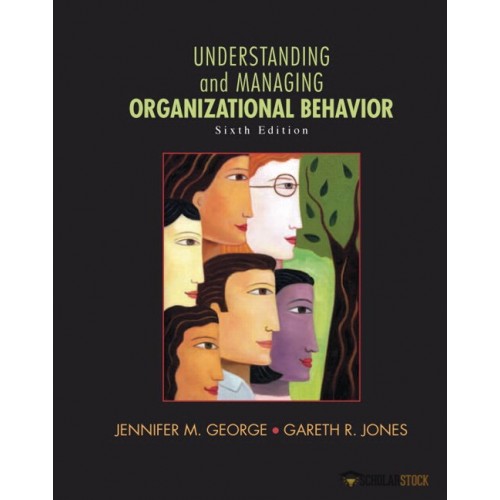Solution Manual for Understanding and Managing Organizational Behavior, 6/E 6th Edition : 0132616173
$35.00
Solution Manual for Understanding and Managing Organizational Behavior, 6/E 6th Edition : 0132616173
You will receive this product immediate after placing the order
A Comprehensive Solution Manual for Understanding and Managing Organizational Behavior, 6/E By Jennifer M. George Gareth R. Jones ISBN-10: 0132616173 • ISBN-13: 9780132616171
Chapter 1: Introduction to Organizational Behavior
PART 1: INDIVIDUALS IN ORGANIZATIONS
Chapter 2: Individual Differences: Personality and Ability
Chapter 3: Values, Attitudes, and Moods and Emotions
Chapter 4: Perception, Attribution, and the Management of Diversity
Chapter 5: Learning and Creativity
Chapter 6: The Nature of Work Motivation
Chapter 7: Creating a Motivating Work Setting
Chapter 8: Pay, Careers, and Changing Employment Relationships
Chapter 9: Managing Stress and Work-Life Balance
PART 2: GROUP AND TEAM PROCESSES
Chapter 10: The Nature of Work Groups and Teams
Chapter 11: Effective Work Groups and Teams
Chapter 12: Leaders and Leadership
Chapter 13: Power, Politics, Conflict, and Negotiation
Chapter 14: Communicating Effectively in Organizations
Chapter 15: Decision Making and Organizational Learning
PART 3: ORGANIZATIONAL PROCESSES
Chapter 16: Organizational Design and Structure
Chapter 17: Organizational Culture and Ethical Behavior
Chapter 18: Organizational Change and Development
CHAPTER 1
Introduction to Organizational Behavior
LEARNING OBJECTIVES
- Define organizational behavior and explain how and why it determines the
effectiveness of an organization.
- Appreciate why the study of organizational behavior improves a person’s ability
to understand and respond to events those take place in a work setting.
- Differentiate between the three levels at which organizational behavior is examined.
- Appreciate the way changes in an organization’s external environment continually
create challenges for organizational behavior.
- Describe the four main kinds of forces in the environment that pose the most
opportunities and problems for organizations today.
*****Use PowerPoint #1 Here. Use PowerPoint #2 and #3 Here to Review Learning Objectives*****
OPENING CASE
Ursula Burns Succeeds Anne Mulcahy as CE of Xerox
How did Xerox’s CEOs turn the company around?
*****Use Power Point #4 Here to Begin the Opening Case*****
In the early 2000s, Xerox, the well known copier company, was near bankruptcy because aggressive Japanese competitors were selling low-priced digital copiers that made Xerox’s pioneering light-lens copying process obsolete. The result was plummeting sales as U.S. customers bought Japanese copies and Xerox was losing billions of dollars. Xerox searched for a new CEO who had the management skills to revitalize the company’s product line; 26-year Xerox veteran Anne Mulcahy was chosen to lead the company’s transformation. Mulcahy had begun her career as a Xerox copier salesperson, transferred into human resource management, and then used her considerable leadership and communication skills to work her way up the company’s hierarchy to become its president.
As the new CEO, the biggest organizational challenge Mulcahy faced was to find ways to reduce Xerox’s high operating costs but, at the same time, find ways to develop innovative new lines of copiers. Specifically, she had to decide how to invest the company’s research dollars to develop desperately needed new kinds of digital copiers that would attract customers back to the company and generate new revenues and profits. Simultaneously achieving both of these objectives is one of the biggest challenges a manager can face, and how well she performed these tasks would determine Xerox’s fate—indeed its very survival.
Class Question
What was the biggest organizational challenge Mulcahy faced as the new CEO?
Answer:
The biggest organizational challenge Mulcahy faced was to find ways to reduce Xerox’s high operating costs but, at the same time, find ways to develop innovative new lines of copiers.
CHAPTER SUMMARY
Organizational behavior is a developing field of study. Changes in the environment constantly challenge organizations and their owners’, managers’, and employees’ ability to adapt and change work behaviors and procedures to increase the effectiveness with which they operate. Major points in this chapter include:
- Organizations exist to provide goods and services that people want, and the amount and quality of these goods and services are products of the behaviors and performance of an organization’s employees.
- Organizational behavior is the study of many factors that have an impact on how people and groups act, think, feel, and respond to work and organizations and how organizations respond to their environments. Organizational behavior provides a set of tools – theories and concepts – to understand, analyze, describe, and manage attitudes and behavior in organizations.
- The study of organizational behavior can improve, and change individual, group, and organizational behavior to attain, individual, group, and organizational goals.
- Organizational behavior can be analyzed at three levels: the individual, the group, and the organization as a whole. A full understanding is impossible without an examination of the factors that affect behavior as each level.
- A significant task for an organization’s managers and employees is to use the tools of organizational behavior to increase organizational effectiveness—that is, an organization’s ability to achieve its goals.
- The activities of most organizations can be modeled as an open system in which an organization takes in resources from its external environment and converts or transforms them into goods and services that are sent back to that environment, where customers buy them.
- Changing pressures or forces in the social and cultural, global, technological, and employment or work environment pose many challenges for organizational behavior, and organizations must respond effectively to those challenges if they are to survive and prosper.
- Two major challenges of importance to organizational behavior today from the social and cultural environment are those that derive from a breakdown in ethical values and from the increasing diversity of the workforce.
- Two important challenges facing organizations from the global environment are to appreciate the differences that exist between countries and then to benefit from this new global knowledge to improve organizational behaviors and procedures.
- Changes in the technological environment, and particularly advances in information technology, are also having important effects on organizational behavior and procedures. IT has improved effectiveness by helping an organization improve the quality of its products, lower their cost, and by promoting creativity and organizational learning and innovation.
- Many changes have also been taking place in the employment or work environment and important developments that have affected organizational behavior include a shortening employment relationship because of downsizing, the growth in the number of contingent or temporary employees, and outsourcing.
CHAPTER OUTLINE
- WHAT IS ORGANIZATIONAL BEHAVIOR?
- An organization is a collection of people who work together to achieve a wide
variety of goals.
1) The individual goals are what people are trying to accomplish for themselves.
2) The organizational goals are what the organization as a whole is trying to
accomplish.
3) Organizations exist to provide goods and services that people want.
- The amount and quality of these goods and services are the result of the
behaviors and performance of the organization’s employees.
4) Today, most people make their living by working in or for some kind of
company or organization.
*****Use organization Here; Use Power Point #5 Here*****
- The Nature of Organizational Behavior
1) Organizational behavior (OB) is the study of the many factors that have an
impact on how people and groups act, think, feel, and respond to work and
organizations, and how organizations respond to their environments.
a An understanding of OB can help people to enhance the positive, and reduce
the negative effects of working in organizations.
*****Use organizational behavior Here; Use Learning Objective #1 Here; Use
Power Point #6 Here*****
2) Most of us think we have a basic, intuitive, commonsense understanding of
human behavior in organizations because we all are human and have been
exposed to different work experiences. However, these thoughts and
assumptions are often wrong.
3) The study of organizational behavior provides a framework for understanding
and appreciating the many forces that affect behavior in organizations.
4) The study of OB provides a set of tools—concepts and theories—that help
people to understand, analyze, and describe what goes on in organizations and
why.
5) In essence, OB concepts and theories allow people to correctly understand,
describe, and analyze how the characteristics of individuals, groups, work
situations, and the organization itself affect how members feel about and act
within their organization.
*****Use Learning Objective #1 and #2 Here; Use Question for Discussion and
Review #1 Here; Use Exhibit 1.1 Here; Use Power Point #7 Here*****
- Levels of Organizational Behavior
1) There are three main levels at which organizational behavior is examined: the
individual, the group, and the organization as a whole.
*****Use Learning Objective #3 Here; Use Question for Discussion and Review #2
Here; Use Exhibit 1.2 Here; Use Power Point #8 Here*****
2) Much of the research in OB has focused on the way in which individuals’
personalities, feelings, and motivation affect how well they do their jobs.
*****Use Exhibit 1.3 Here; Use Power Point #9 Here*****
3) The effects of group or team characteristics and process on organizational
behavior need to be understood.
a A group is two or more people who interact to achieve their goals.
b A team is a group in which members work together intensively and develop team-specific routines to achieve a common group goal.
c A virtual team is a group whose members work together intensively via
electronic means using a common IT platform, and who may never actually meet.
Be the first to review “Solution Manual for Understanding and Managing Organizational Behavior, 6/E 6th Edition : 0132616173” Cancel reply
Related products
Solution Manual
Understanding Business Nickels 10th Edition Solutions Manual
Solution Manual
Solution Manual for Psychology and Life 20th Edition by Gerrig
Solution Manual
Solution Manual for Introduction to Electrodynamics, 4/E 4th












Reviews
There are no reviews yet.